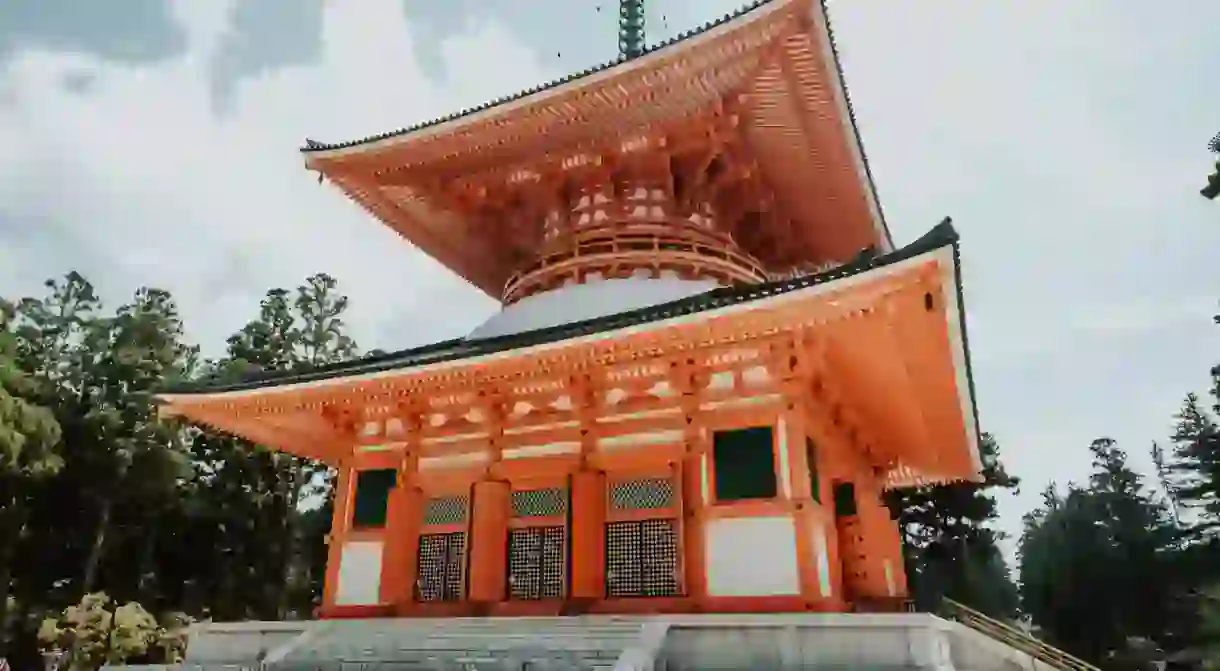Danjo Garan: The Spiritual Home of Shingon Buddhism

Koyasan, an ancient holy temple complex, is one of the most important religious sites in all of Japan. The religion’s founder, Kobo Daishi, taught his disciples right here in Koyasan’s Danjo Garan temple complex, the birthplace of Shingon Buddhism.
Legend has it that Shingon Buddhism arrived in Japan over 1,000 years ago. A Japanese monk – who went by the name Kukai – was returning home from his travels in China. He had studied Buddhism and wanted to teach others what he’d learnt. But he had no idea where to set up such a school.
Praying for guidance, he eventually decided to let his sanko (ceremonial trident) settle the matter; he would establish the temple wherever it landed. He threw it and, quite miraculously, it travelled across the ocean and landed in a pine tree at the top of a mountain. Koyasan, his new home, was nestled within the peaks of eight mountains, like the petals of a lotus flower. For centuries, this temple complex has remained a place of learning and teaching. It’s also a place of pilgrimage for monks to pay their respects to Kukai, posthumously named Kobo Daishi, whose spirit lives on in Okunoin Cemetery.

Miedō「御影堂」(Great Portrait Hall)
Miedo was once the spot reserved for Kobo Daishi’s private meditations. It has since been dubbed the “Great Portrait Hall” because a painting of the founder himself resides inside. Visitors are only allowed in one day a year on 21 March, the date of the Kyusho Mieku Festival, to admire the portrait.
In front of Miedo stands Sanko no Matsu, the tree said to have been punctured by Kobo Daishi’s trident.



Konpon Daito「根本大塔」(Great Pagoda)
This brightly coloured pagoda is the highlight for most visitors. Painted vermillion and towering 45 metres tall, it stands out as one of the most picturesque parts of the tour. Not only is it aesthetically pleasing, but it is also imbued with spiritual significance.
Surrounded by eight mountain peaks, it seemed to Kobo Daishi that the centre of these peaks was a real-life representation of a mandala (Sanskrit for “circle”). A mandala is used as a guide or object of meditation to visualise enlightenment – it’s usually the centre of a geometric pattern. But Kobo Daishi decided that The Great Pagoda should be made the centre point of this real-life manifestation of a mandala.
Fittingly, a statue of the Dainichi Nyorai, the central Bodhisattva of the Shingon sect, lives inside. This Bodhisattva, whose Japanese name means “Great Sun”, symbolises the centre of all things and is a cosmic force that illuminates the universe. He is often depicted at the centre of a mandala surrounded by the other four members of the Great Wisdom Kings.


Saito「西塔」(Western Stupa)
Saito is a unique type of pagoda known as tahoto. This is a special Shingon style, which has an even number of stories. Traditionally, pagodas have an odd number of levels; there are no examples of tahoto-style structures in China or any other countries where Buddhism is worshipped. Such structures are rare even in Japan these days and many tahoto pagodas have been named Important Cultural Properties.


Aizen-dō「愛染堂」(Aizen Hall) and Daie-dō「大会堂」(Daie Hall)
Peer inside the Aizen-do to catch a glimpse of a deity called Aizen Myoo, who represents love and passion. The surrounding structures are appropriately alluring.



Kondō「金堂」(Golden Hall)
Major religious ceremonies are held in this large wooden hall, which also enshrines the Buddha of healing and medicine. Though it has burned down many times over the years, as is common with historic Japanese buildings, the current iteration is based on the original design and is nearly 100 years old.

Rokkaku-Kyozo「六角経蔵」(Hexagonal Depository of the Scriptures)
This building has an interactive revolving floor. It once contained sacred religious texts written on blue paper in golden ink.

Myō-jinja「御社」(Myō Shrine)
As one of the few Shinto sites in the town, Myō Shrine exemplifies the cohesive nature of Japan’s two most popular religions. It is home to a female mountain deity and her son, a forest-dwelling hunter guardian. Allow them to watch over you as you step into the shade of the surrounding cedars for some quiet contemplation.

Dango Garan
Buddhist Temple, Shinto Shrine, Historical Landmark

Danjo Garan is a complex in the holy town of Koyasan composed of many religious structures, both Buddhist and Shinto. Consisting of a shrine, bell tower, pagodas, storage areas for ancient scriptures, ceremonial halls dedicated to various deities and the site where only Kobo Daishi – the famed founder of this spiritual place – himself was allowed to meditate, it is a treasure trove of holy sights. Wandering this vast compound is a magnificent journey through some of the nation’s most venerated history.













